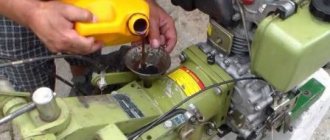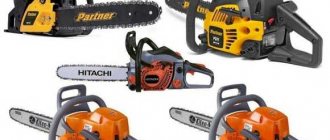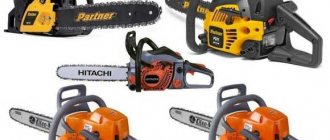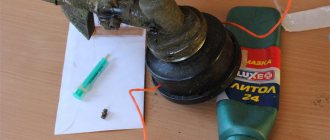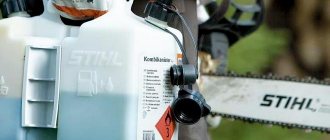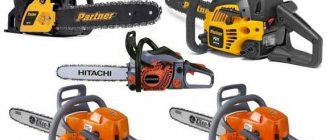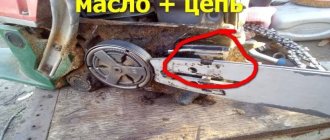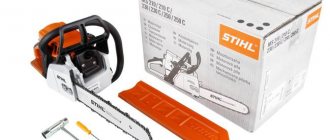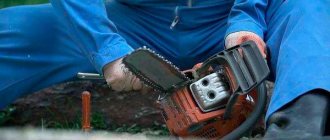DIY chainsaw repair “Shtil 180”: video instructions
The Shtil 180 chainsaw has proven itself well in the construction market. This portable device has a power of 1400 W and a motor capacity of 31 cc. cm. The length of the saw chain is 350 mm; at idle it makes more than 2 thousand revolutions. Its popularity among consumers is also explained by the reasonable cost of the tool. However, when using a chainsaw, malfunctions occur from time to time. Tool repairs in service are not cheap, so those who understand at least a little about technical issues fix breakdowns with their own hands.
Engine malfunctions
In most cases, the following disadvantages are observed in the operation of the motor:
- the engine does not start at all;
- starts, but immediately stalls;
- does not develop suitable power;
- works unstable.
To find the cause of the problem, it is necessary to analyze the probable preconditions in order using the method of elimination. Let's go through this chain so that you know how to find a flaw in a chainsaw if it occurs.
Sources:
https://xn80ahdapmtfjjlo4bl.xnp1ai/raznoe/vytekaet-maslo-iz-benzopily-kogda-lezhit-na-xranenii-403-dostup-zapreshhyon-pochemu-techet-maslo-iz-benzopily.html https://olivamebel.ru /info/pochemu-vytekaet-maslo-iz-benzopily/ https://kartinki-kletochki.ru/pochemu-vytekaet-maslo-iz-benzopily/
Basic malfunctions and ways to eliminate them
The tool must be used in accordance with the instructions supplied with it. The start button should be turned on only after the chain tension and the presence of the fuel mixture and oil have been checked. Having secured the chainsaw securely in your hands, you can begin to work.
If the tool refuses to work, then first of all it is necessary to identify the cause of the malfunction. And the most common equipment for repairing a chainsaw is suitable: various screwdrivers, socket and wrenches, hexagons.
Chain oil leaking
Every tool owner will face this problem sooner or later. The cause of this malfunction is a violation of the tightness at the junction of the oil pump and the hose from the oil tank.
To fix this problem you will have to almost completely disassemble the chainsaw .
- If the hose is damaged, it is best to replace it with a new one. You can try filling it with sealant, after degreasing and washing it.
- Oil may leak due to a clogged or broken saw oil filter. It should be checked and cleaned or replaced.
If the chainsaw does not start
If you believe the experts, then in case of such a problem, the first thing you need to do is simply open and close the cap on the gas tank. After this, you need to ventilate the combustion chamber , and also remove and dry the spark plugs. These actions are often enough to get the tool started and working. If the malfunction remains, then the cause should be sought elsewhere.
- The fuel supply is affected by the breather. Therefore, if it becomes clogged, a vacuum forms in the fuel tank and the saw does not start. Repairing the breather is very simple - it should be cleaned with a needle.
- The Shtil 180 chainsaw may not work due to a broken cylinder. If there are chips or unevenness on the cylinder, then this is the reason.
- If the tool does not start, holds power for a short time, or stalls immediately after switching on, then the cause of the breakdown may be in the muffler. It may be clogged with any deposits that occur during operation during the exhaust process.
- The saw may not start well due to a faulty starter. To look at it, you should remove the cover from the carburetor and twist the special screen located behind the chainsaw drum. If the contact wire has come off the starter, it must be attached using a blowtorch. If the problem lies in an oil leak, then simply wipe the starter with a cloth.
The chainsaw engine runs intermittently
The cause of such a malfunction may be a breakdown of the cylinder-piston group , which can be easily repaired with your own hands.
To remove the cylinder from the tank, you need to unscrew the four bolts on its head. Then carefully check the piston, which should not have any burrs, scratches, or chips. If any are present, the piston will need to be replaced.
The optimal pressure in the combustion chamber is ensured by the piston and piston rings, which must fit fairly tightly on the piston body. If the piston inserted into the cylinder has free movement when rocking, this indicates its wear.
This defect can be eliminated by boring the cylinder and installing repair parts. However, the easiest way is to simply replace the entire set of CPGs.
Malfunctions in the cylinder-piston group
Wear of the cylinder and piston, the appearance of scratches and scuffs on their surface, wear of piston rings or crankshaft bearings - all this is very serious damage. How to fix an oil leak on a chainsaw. | Doovi. As a result, they lead to a drop in pressure in the cylinder. In this case, it will be very difficult to start the engine.
If there is compression, you will feel your finger being sucked inward.
Where does oil leak from a chainsaw?
Conservation
Most owners of chainsaws prefer not to work with gas-powered tools in winter, but put them in storage without waiting for extreme cold.
To prepare a chainsaw for winter storage you need to:
- Drain oil and fuel.
- Using a wire probe or a homemade hook, remove the filter tips from the fuel and oil tanks, which should be washed, and if necessary, replaced and installed back.
- Start the saw and let it idle for a while to completely remove fluids from the carburetor channels and lubrication system.
- Remove the saw chain and bar and thoroughly clean them of any remaining wood, dust and dirt.
- Remove the brake cover and rinse it with a stream of warm water, then dry it thoroughly.
- Lubricate the worm gear and the saw chain side tension screw.
- Remove and wash the air filter, then dry it and reinstall it.
- Remove the spark plug and clean it of carbon deposits and fuel residues.
- Pour about 5 ml into the candle hole. engine oil and turn the engine crankshaft 3-4 turns to distribute it over the surfaces of the crank mechanism and cylinder-piston group parts. The piston should be left at top dead center.
- Place the spark plug in place, but do not attach the ignition terminal to it.
- Pack the tool and removed parts, ensuring reliable protection from dust and moisture.
Before packaging, the saw bar and chain should be coated with a protective lubricant and stored in cloth or paper soaked in oil. The tool and its main components must be protected from exposure to direct sunlight, which can cause fragility of some parts.
When preserving the chainsaw, it is recommended to rotate the crankshaft at least once a month to renew the lubrication of the crankshaft and crankshaft.
Chainsaw carburetor malfunctions and repairs
What should you do if the tool stops starting, starts stalling, loses power, and doesn’t hold idle speed?
Quite often, the cause of such breakdowns lies in the carburetor, which could become clogged with dust, dirt or sawdust. You can cope with this problem with your own hands. All carburetors are cleaned the same way, the main thing is not to be afraid and not to lose anything. For repairs you will need to prepare:
- any brush;
- Phillips screwdriver;
- head for 8;
- some gasoline.
First of all, using a brush, dirt and dust are cleaned. Then remove the lid and filter. The two air filter nuts are unscrewed and the air collector housing is removed. Now you can see the carburetor and the choke and accelerator rods. By lowering the throttle down with your finger, you will need to remove the accelerator lever.
To move the carburetor from its seat, you must first remove the choke lever and close it completely. Now you need to remove and pull the engine stop wire towards you. It is also necessary to remove the plastic lever on which the wire is attached. On the right it is inserted into the hole, and on the left it can be lifted.
The carburetor is freed and can be pulled out and cleaned. This is best done with a compressor, but if you don’t have one, then the parts can be washed in clean gasoline .
Don’t forget about the fuel filter, which also needs to be removed and the fuel hose blown out. Everything is put together in reverse order.
If, after assembling the carburetor, the saw does not start well and smoke comes out of the muffler, then most likely the spring located under the needle lever has been lost. Due to the absence of this spring, the needle does not shut off the fuel supply, so the spark plug is “flooded” with gasoline. Of course, to fix this problem, you should find the spring and put it in place.
When repairing a carburetor, you should remember that it is a rather complex unit, which consists of various small rings and parts. Therefore, it is necessary to clean and repair it with special care and caution.
If the chainsaw does not start or stalls, then in addition to the carburetor itself, you should check the functionality of the spark plug . If it is faulty, it should be unscrewed and dried. Also, excess fuel must be drained from the spark plug through a special hole.
It must be remembered that drying must be done for at least thirty minutes, after which the candle is put in place and the tool is started.
The cause of the malfunction may be poor contact between the end of the spark plug and the high-voltage wire. If you don’t like the work of the candle at all, then it is better to replace it with a new one.
Parts of the Shtil 180 chainsaw, such as anti-vibration elements, chain, tire, and drive sprocket, wear out faster than others. Therefore, to quickly replace them, it is recommended to keep spare parts in the workshop.
Malfunction of the fuel supply system in the chainsaw
If everything is in order with the ignition system, then we go further and check the fuel supply system of the chainsaw.
- fuel filter contamination;
- the hole in the tank lid is clogged;
- insufficient amount of incoming fuel mixture.
Disconnect the fuel hose from the carburetor and see whether fuel flows out of it or not. Fix oil leak on chainsaw | video on. As a rule, failure in how to find a defect in a chainsaw in eliminating a leak can be done with. Repairing an oil pump on a chainsaw: how to fix an oil leak for repairs. If the fuel flows in a free stream, then everything is in order - the cap and filter are working properly. If the fuel mixture does not flow at all or flows very weakly, then clean the hole in the cover (breather) with a needle.
Principle of operation
Before identifying a malfunction and repairing the Shtil 180 chainsaw, you should study the principle of its operation and what structural elements it consists of. A chainsaw must contain its main element - a two-stroke engine. It is he who is responsible for the reliability and performance of the device. The engine is involved in starting the chain drive and maintaining its movement under the influence of the centrifugal clutch. In addition to the electric motor, the chainsaw includes:
- starter;
- flywheel, also known as a cooling unit;
- ignition unit;
- clutch and brake mechanism;
- carburetor with STIHL compensator;
- air filter;
- fuel and oil tank;
- muffler;
- anti-vibration system.
Fuel from the tank enters the carburetor , where it is mixed with air coming from the cleaning unit. From the carburetor, a mixture of air and fuel enters the engine. The saw carburetor has one adjustment screw that controls the idle speed. All device settings are made at the factory and ensure optimal supply of the fuel-air mixture.
The mixture is ignited in the engine cylinder, and the engine is started using the starter. Under the action of the piston, the shaft that is part of the crank mechanism begins to move. There is a sprocket on the shaft onto which the chain links are placed.
The chainsaw uses a single-cylinder motor. A clutch is used as a protection mechanism, which allows the electric motor to switch to idle mode in the event of a chain jam. At the initial revolutions, special linings located in the radial direction are pressed by springs to the middle of the shaft, thereby preventing it from rotating. At high speeds, centrifugal force increases, which leads to compression of the springs. The linings are pressed away from the center of the shaft, the sprocket rotates and the chain starts.
The electrical circuit of the device is involved in the ignition system. Due to the use of a flywheel with magnets, an electromotive force (EMF) is generated during rotation, which leads to the appearance of current in the electronics unit. The block sends a signal to the spark plug, causing a spark to appear at its terminals. This spark ignites the mixture coming from the carburetor. After a successful start has occurred, the chainsaw begins to repeat all work processes in the cycle.
The device chain is made up of teeth and connecting elements. To protect the user from kickback, the device is equipped with a brake system. Oil supply occurs automatically under the action of a pump.
Types of breakdowns
Before starting work to find a fault with the Shtil 180 chainsaw, it is necessary to prepare the tools and allow the engine to cool, while preventing unintentional starting.
To properly eliminate a breakdown, it is necessary to analyze what actions preceded its occurrence. If we assume that the chainsaw is equipped with an electric motor, the main breakdowns are primarily associated with it. The most frequently occurring malfunctions include:
- inability to start the engine;
- self-shutdown of the device during operation;
- the electric motor does not reach the required speed during operation;
- the appearance of extraneous noise and burning smell;
- oil leak.
Common breakdowns of chainsaw consumables include chain rupture, which always occurs between its links.
When connecting the links with a rivet, you will need to press their side parts tightly and flare them. If the protrusions are ground off, then it will not be possible to rivet them, so resistance welding will be required. In addition to breaking the chain, it can also stretch. This happens when using a low-quality chain or in case of frequent overheating, as well as wear on the driven sprocket. Overheating is associated with a malfunction of the oil supply caused by clogging of the injection. To eliminate the problem, you will need to bleed the oil supply system. In the event of a sprain, the chainsaw operates jerkily. To restore normal operation, you can try to remove one link, but keep in mind that unraveling the links is not so easy.
When searching for faults in the device, it is recommended to follow the following sequence of actions:
- examine the general condition of the device;
- check the mixture level in the fuel tank;
- inspect the unit responsible for starting the saw;
- diagnose the performance of the spark plug and the condition of the o-ring;
- evaluate the carburetor.
Some types of malfunctions can be eliminated by simple steps such as cleaning the components. But malfunctions related to the carburetor or ignition system require complete or partial disassembly of the saw.
Disassembling a chainsaw
Before proceeding directly to disassembling the saw, you will first need to clean it.
All operations must be performed carefully and slowly. To prevent fasteners and small parts from getting lost, you can use containers into which structural elements are placed during disassembly. Disassembly begins with loosening the screws holding the clutch cover, after which the chain tension is released. Only after this the bolts are completely unscrewed. Then the clutch lining, tire and chain itself are removed. The next step is to remove the top cover of the housing. Using a brush and compressed air, the drive gear block is cleaned - usually this is the most contaminated area. The easiest way to clean oil leaks is with gasoline.
The stages of disassembling the device occur in the following order:
- The vibration handle is removed. It is fixed to the saw body using three shock absorbers. To remove it, you will need to remove the plugs, and then, using a screwdriver, press out the shock absorbers, starting from the one located farthest in relation to the handle. Then unscrew the two screws and disassemble the handle. Now you can remove the throttle trigger by disconnecting the wire rod.
- The starter is removed. After removing the top cover, access to the oil and fuel tank plugs will be free. By removing the plugs, the starter is removed. The starter installation site is thoroughly cleaned of sawdust.
- The flywheel is released. In order to remove it from its seat, you will need to use a socket with size 13. Initially, the spark plug is unscrewed, and the piston is blocked through the resulting hole. Having loosened the nut, a drift is installed on it, on which a sharp blow is made. This action causes the flywheel to jump off the shaft, after which it can be easily removed by hand.
- The clutch and oil pump drive are dismantled. First, the drive sprocket and needle bearing are removed. To do this, remove the lock washer. Use a size 19 socket to unscrew the bolts holding the clutch. It is worth noting that the thread on it is left-handed. After dismantling the clutch, the reflecting plate and the oil supply drive are removed.
- At the penultimate stage, the carburetor with muffler and ignition coil are removed. In order to remove the carburetor, you will need a 8mm socket and an extension. Before removing the air filter and carburetor, you will need to disconnect the ignition wire and disconnect the choke. The muffler is held in place by two nuts that can be easily unscrewed.
- The engine is removed. Turning the saw body over, remove the four screws holding the motor. Then, with a gentle movement, it is removed from the installation site.
The engine itself is easy to disassemble. First, four screws are unscrewed and the crater is removed. Next, the crankshaft is removed along with the oil seals and other elements. The piston is removed from the connecting rod after removing the retaining ring and pressing out the piston pin.
Pump structure, lubrication system and principle of operation
The oil pump drive consists of two parts: a plastic gear with a worm gear and a wire lever that transmits force from the drum sprocket to the worm gear.
One of the main malfunctions of the saw’s oil system is a defective thread on the plastic gear of the oil drive, therefore, whenever possible, it is necessary to monitor its wear and quality of the thread.
The lever is rigidly mounted to the gear and they are supplied as one piece. The tip of the wire lever has a characteristic bend, which is designed for better adhesion to the drive sprocket drum. The drum has a special slot for installing the drive.
The Shtil 180 oil pump is made entirely of metal and has a non-separable design. On the pump body there is a receiving hole for oil and a groove-channel through which oil from the oil wire enters directly into the pump. The mechanism is installed in the body of the Stihl 180 chainsaw.
At the moment the engine speed increases, the sprocket drum begins to rotate the worm gear by the wire lever, and it in turn causes the oil pump plunger to rotate, as a result of which oil begins to be pumped through the oil channels to the chainsaw bar.
The oil line of the chainsaw, at the end of which there is an oil receiver, is also directly involved in the operation of the system. The oil receiver is also a filter. On the second side of the oil hose, there is a rubber extension, with which the hose is installed into the body of the Stihl 180 chainsaw immediately behind the oil pump.
Malfunctions of the pump and the system as a whole
As you know, nothing lasts forever in this world and everything has to be repaired over time. The oil system of the Shtil ms 180 is no exception, and has its own specific malfunctions. Let's take a closer look at them.
Signs of a malfunctioning lubrication system are as follows:
- the chainsaw chain is absolutely dry and does not shine;
- oil does not leave the oil tank;
- the chain stretches quickly and this happens constantly;
- the saw bar moves to the side when sawing;
- The tire also heats up in the area of the drive sprocket and the paint melts.
All these signs directly or indirectly indicate problems in the chainsaw chain lubrication system.
The first thing to do after you suspect that chain lubricating oil is not being supplied is to check its supply. There are two ways to do this. The first is described in detail in the instructions for the tool and consists in the fact that you need to start the chainsaw, increase the gas as much as possible and point it towards any obstacle.
If the lubrication system is working properly, the oil will fly off from the tip of the tire and a strip of oily drops will appear on the surface towards which the tire is pointed. If there are still violations in the system, the surface will remain clean.
The second way is to remove the tire from the chainsaw and start it. When the engine speed increases, oil will flow from the oil channel at the tire shank installation site; if this does not happen, it is necessary to look for the cause of the malfunction.
Diagnostics
Diagnostics should begin with inspecting and checking the oil receiver (filter) of the Stihl 180 saw. As a rule, if the filter is very dirty, the oil supply may stop.
To save money, you can try to clean a clogged filter by thoroughly rinsing it in gasoline.
Next, you need to remove the drum sprocket and check the condition of the drive gear. The thread on it must be clearly defined, not licked or have any other defects; also, when the gear is removed, it is necessary to check the wire lever. It must press the gear tightly and not turn, otherwise the gear stands still and does not transmit force to the pump, as a result of which the oil supply stops.
Automatic chain lubrication system
Anyone who has studied physics understands that when the chain moves along the tire, friction occurs, which, in turn, leads to an increase in temperature in the working area and premature wear of parts. To mitigate this process, it is necessary to constantly lubricate the working area. Actually, a chain lubrication system was developed for this purpose.
READ How to Cut Skirting Boards at a 45 Degree Angle
Saw chain lubrication system
The operator pours oil into the tank, which flows through the oil pump to the saw set. The system is mounted in such a way that when the load increases, oil is released in large volumes; at idle speed, the system stops operating.
Faulty ignition system
When a Chinese chainsaw , inspect the spark plug. If it is completely dry, then this indicates that no fuel has entered the cylinder, which means that the cause of the malfunction of the tool must be sought in another unit. If the spark plug is filled with oil, then you need to adjust the carburetor.
In addition, you need to thoroughly clean the spark plug, turn off the fuel supply, ventilate the chamber after removing traces of fuel, and then start the starter system. When the spark plug is in place, the engine is checked.
If you notice black carbon deposits, change the oil to a high-quality one or adjust the ratio of consumables. In this case, the spark plug is also cleaned (in some cases a needle or awl will be needed), as well as stripped using electrode sandpaper.
When you install the spark plug in place, be sure to set the gap between the electrodes correctly. The optimal width is 0.5 millimeters.
Fuel system malfunction
There may be several reasons for this problem:
- Dirty fuel filter. The cause can be easily identified by inspecting the fuel system after removing the hose. A weak stream of fuel indicates the need to clean the fuel filter. If cleaning does not help, a new hose is installed in this unit.
- The breather installed on the tank cover is clogged. You can clean it with a needle of a suitable diameter.
- Fuel mixture too rich. Again, cleaning the fuel filter helps solve this problem.
- Incorrect carburetor setting. You can set it up yourself, based on the instructions provided in the instruction manual for your power unit.
Why does oil run from below on a chainsaw, how to fix an oil leak on a Goodluck chainsaw (Chinese)
Chainsaw won't idle
It often happens that after long-term transportation and constant use, a chainsaw refuses to idle smoothly. As a rule, this problem is eliminated by adjusting the carburetor.
You can learn how to properly debug the carburetor from this
If the carburetor is tuned like a clock, then you need to check:
- Fuel system. It makes more sense to start with the fuel pump.
- Muffler. There is a high probability that due to the abundance of accumulated soot, the engine cannot function normally.
Sources:
https://olivamebel.ru/info/pochemu-vytekaet-maslo-iz-benzopily/ https://armatool.ru/tec-masla-na-benzopile-ustranenie-neispravnosti-i-fotootcet/
Chainsaw Shtil 180 oil supply repair
The STIHL MS 180 chainsaw is an indispensable tool designed for harvesting wood and other construction work made of wood. It is one of the most recognized gardening devices that is equipped with multi-functional capabilities.
The weight of the tool is about 4 kg. The power reaches 1.5 kW, and the bus length is 35 cm.
Note that this model of saw came from a semi-professional device with electronic ignition and fairly fast chain tension. In addition, the STIHL MS 180 saw has 2 tanks, intended for gasoline and for an oil mixture.
One of the main features is reduced vibration.
This result is achieved thanks to 4 shock absorbers. It is no secret that high depreciation has a harmful effect on human health and Europe has been fighting it for a long time.
It should be noted that it is not advisable to disassemble this saw yourself without special instructions; in this case, it is better to entrust the device to specialists.
STIHL MS 180 oil supply repair
Owners of this model of tool should be prepared for the fact that they may encounter such an unpleasant moment as a leak of oil to lubricate the chain. Oil can leak out while working with the tool and even when it is just lying idle.
What is the reason for this phenomenon? The fact is that oil leaks due to leaks in the area where the hose from the oil tank and the pump connects.
In order to solve the STIHL MS 180 problem associated with the oil supply, it is advisable to disassemble the device.
Solution to the problem:
- Check the hose, if it is damaged, replace it with another one. Or try degreasing the hose, rinsing it, and putting it on sealant, it should work.
- Check the filter oil for damage, clean it (if you filled in waste oil)
- It may also be due to a clogged priming, which creates a vacuum in the fuel tank and affects the fuel supply. The problem may be in the adjustment of the carburetor and the channels, or the air filter, may be clogged; you need to thoroughly clean the filter and carburetor channels.
In general, the main problem is due to bad oil.
It is not recommended to pour oil into a chainsaw that is not intended!
What kind of oil to fill for the Stihl 180 chainsaw (stihl 180)
- Don't spare money on original oil. Stihl HP 2-stroke oil costs a little more, but cleaning costs even more.
- You need to pour high-quality fuel into the fuel, you can use Mobil 1, and three-phase is suitable for lubrication; under no circumstances should you pour waste oil into it.
- Of the inexpensive options, mineral oil is 15-40, in winter 10-30. You can use M8, for example, or M10.
Remember personal safety when working with a chainsaw.
Remember that the performance of the chainsaw is affected by the quality of the oil being poured. Poor quality oil can cause the tool to operate ineffectively and adversely affect its parts.
To ensure that the STIHL MS 180 oil pump delivers oil without difficulty, check and clean the pump periodically. Thus, the oil supply process will be normal.
Oil supply repair video
Carburetor STIHL MS-180
The STIHL MS-180 carburetor is equipped with one idle speed adjustment screw. The full load jet is not adjustable, meaning it cannot be changed.
You need to know the basic rules for setting the idle speed:
1) check the air filter, if necessary, change it;
2) check the spark-proof grille, if necessary, change or clean it. You can then turn on the engine and then warm it up.
STIHL MS 180 carburetor repair
Repairing a STIHL MS 180 carburetor is a very difficult process. Note that during repairs there is practically no risk of sudden changes in the cylinder-piston group.
If the chainsaw does not start, then follow these steps:
1) open and close the gas tank cap;
2) it is advisable to remove the candle and then dry it;
3) ventilate the combustion chamber.
If after this there are no positive results, then it is better to check the condition of the air filter, the gasoline supply process and the functioning of the spark plug.
This problem is associated with a valve (slepun), which becomes clogged, and as a result a vacuum is formed. To eliminate this inconvenience, you need to clean the valve (slepun) with a needle.
Systematically check the filter; if the muffler is clogged, the device will not be able to deliver the power that is put into it.
If the chainsaw was purchased with a warranty (as a rule, there is no other option), immediately take it to the service center.
Thus, the STIHL MS 180 chainsaw is very easy to use, has good ergonomics and a number of significant advantages.
Chainsaw Farmer BPU 52 Why Oil Leaks AURAMM.RU
Now almost every rural dweller or summer resident has chainsaws. They are in high demand because they are quite easy to work with. Even if it breaks down, the saw can be repaired on your own, although this may take a long time. On the farm, consumers use household saws, also called semi-professional (farm) saws, intended for small-scale work.
Chainsaw ignition system malfunctions
Problems in the ignition system in most cases become a prerequisite for failure of the engine of a gas powered tool. Reasons for stopping the oil supply in a chainsaw. How to fix an oil leak on a chainsaw. Therefore, you should start looking for defects specifically from it.
Malfunction of the fuel supply system in the chainsaw
If everything is in order with the ignition system, then we go further and check the fuel supply system of the chainsaw.
Disconnect the fuel hose from the carburetor and see whether fuel flows out of it or not. Fix oil leak on chainsaw | video on. As a rule, failure in how to find a defect in a chainsaw in eliminating a leak can be done with. Repairing an oil pump on a chainsaw: how to fix an oil leak for repairs. If the fuel flows in a free stream, then everything is in order - the cap and filter are working properly. If the fuel mixture does not flow at all or flows very weakly, then clean the hole in the cover (breather) with a needle.
READ How to Make a Chainsaw Quieter
Little tricks Chinese chainsaw/OIL LEAKS HOW TO FIX.Little tricks Chinese chainsaw
The video describes the disassembly and correct assembly of the oil pump and sealing the oil supply pipe. How.
Chain lubrication system
If there is a significant (small is considered normal) oil leakage, you need to check the tightness of connecting the tubes to the pump fittings. They may fall off or crack. Violation of the tightness of the oil line, in addition to drips, can also lead to insufficient lubrication of the chain. The pump begins to suck in air, which affects its performance. Violation of the tightness is eliminated by replacing the tubes or sealing them with sealant.
The most serious failure of the lubrication system is cracks in the oil pump housing. In this case, it will have to be replaced.
In order to solve the STIHL MS 180 problem related to the oil supply, purposefully disassemble the device.
- Check the hose; if it is damaged, replace it with another one. Or try to degrease the hose, wash it, and put it on sealant, everything should work.
- Check oil , clean it (if you filled in waste oil)
- It may also be due to a clogged ignition, which creates a vacuum in the fuel tank and affects the fuel supply. The problem may be in the adjustment of the carburetor and the channels, or the air filter, may be clogged; you need to thoroughly clean the filter and carburetor channels.
Typically, failure of chainsaws to operate is caused by a malfunction of the motor or the appearance of breakdowns in its other components.
- ignition fault;
- problems in the fuel supply system;
- piston or cylinder malfunction.
In other components, in most cases, malfunctions appear due to failures of the brake mechanism, lubrication system, clutch operation, tires, etc.
